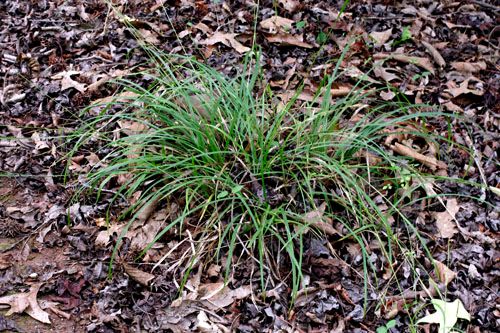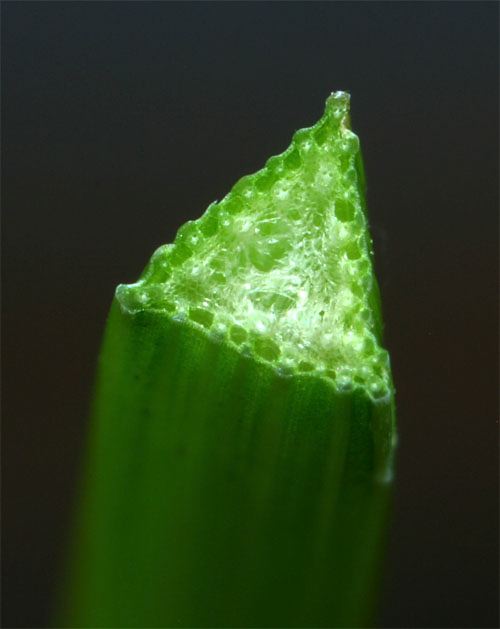|
|
|||
THIS WEEK at HILTON POND
15-30 June 2006
Installment #320---Visitor #
(Back to Preceding Week; on to Next Week)
|
SEDGES HAVE EDGES . . .
When leading Guided Field Trips down the trails at Hilton Pond Center, we often come across clumps of green plants with narrow, grass-like leaves. Invariably, when we ask folks what the plants are, they respond with "some kind of grass." Often they're right--but sometimes they're not--at which point we ask them to grasp a stem of the plant 'twixt thumb and forefinger and describe its shape. If the stems AND leaves are all flat--as they are in the cluster of foliage illustrated in the photo just below--they likely would be correct in calling the plant a grass, but if the stem feels round or triangular it's something altogether different, at which point we'd be inclined to sing out this mnemonic little ditty:
All text & photos © Hilton Pond Center Grasses, sedges, and rushes are all vascular plants--they have specialized tissues that conduct water and minerals (via xylem) and food (via phloem) and also produce flowers and fruit--but within the plant world they are relatively primitive and are classified as monocotyledons. (Monocots have only one embryonic leaf in each seed, while the "higher" dicots such as acorns and beans have two.) Only a few grasses, sedges, or rushes develop woody tissue or reach heights of more than a few feet, and many are ground-hugging annuals that survive in a given locale only because of their prolific seed production. Nonetheless, these three kinds of plants are pervasive worldwide; one manual of flora lists 89 genera and 325 species in the Grass Family (Poaceae) and 16 genera and more than 280 species of sedges (Cyperaceae) and rushes (Juncaceae)--and that's just in North and South Carolina! One thing grasses, sedges, and rushes have in common is their flowers are relatively inconspicuous--even though blossoms on grasses are productive enough to yield clouds of pollen that causes hay fever in human sufferers. In general, flowers of all these plants are tiny and yellow-green, rust, or tan in color (see rush flowers above), so most folks--even experienced naturalists and botanists--often can identify only a handful of grasses, sedges, and rushes from memory by looking at floristic parts.
Fruits of the three plant groups in question are a bit more distinctive than their flowers, with some sedges producing inch-long prickly clusters of beak-like fruits (above); by comparison, many rushes make tiny globular fruiting structures (below) less than one-eighth-inch in diameter. Fruits of grasses are more variable, from plump kernels on an ear of sweet corn to the tiny, expensive seeds many folks scatter to create lawns that eventually get overtaken by free seeds from invasive grass species such as Crabgrass.
So if grasses and sedges and rushes look so much alike at first glance, what's a body to do when trying to differentiate them? Once again it's time to call upon that little poem we mentioned at the beginning of our photo essay:
Indeed, a simple "touch test" is the giveaway for sedges, whose stems when rotated have a very noticeable triangular shape--hence a total of three "edges." To illustrate this characteristic, we clipped a flowering stem from a sedge and brought it back to the lab at Hilton Pond Center, where we made a fresh cut with a razor blade and placed the stem in front of our 3:1 macro lens. This allowed us to make the photomacrograph below that readily shows not only the triangular stem but also the sedge's vascular conductive tissue. (Keep in mind this is a highly magnified view; the stem is only about one-sixteeth-inch on each flat side!)
For the sake of comparison, we followed the same procedure on a rush stem and a stalk of grass. In our two other photomacrographs, the cylindrical ("round") nature of the rush's one-sixteenth-inch diameter stem is obvious (below) . . .
. . . while the grass (below) has a somewhat flattened stem that is noticeably "hollow." In both the rush and the grass vascular tissues are again visible.
We don't recommend clipping wild specimens just to learn whether they might be grasses, sedges, or rushes--after all, cutting kills the amputated part--but we do advocate a harmless "touch test" in the field to discover whether the plant is a sedge with triangular stems or a rush with round ones. Grasses--which typically have flattened stems and leaves--will be revealed by process of elimination, although it's important to remember to feel the sedge's triangular STEM rather than its flat LEAF. It should also be noted that a few genera of rushes (especially Juncus and Luzula spp.) may have flattened stems. If in doubt about grasses, sedges, and rushes next time you're exploring a natural area like the habitats around Hilton Pond, just reach down and touch those mysterious grass-like plants, being careful to avoid Poison Ivy and all the while chanting our charming and unforgettable chorus:
All text & photos © Hilton Pond Center Thanks to Donna Wright of North Carolina State University for input POSTSCRIPT: After posting this week's installment we heard from several folks who had different lyrics to the sedge-rush-grass rhyme. In particular, Kathy Miner of the University of Wisconsin-Madison Arboretum said her botany instructor taught it as:
Nodes are the conspicuous raised places on a grass stem that give rise to the leaves; the structures are much less obvious in sedges and rushes. Kathy also had heard:
This iteration refers to the way leaves of grass wrap around (clothe) the stem--as illustrated in our cross-section photo just above. Comments or questions about this week's installment?
Thanks to the following fine folks for recent gifts in support of Hilton Pond Center for Piedmont Natural History and/or Operation RubyThroat: The Hummingbird Project. Your contributions allow us to continue writing, photographing, and sharing "This Week at Hilton Pond." (See Support if you'd like to make a gift of your own.)
"This Week at Hilton Pond" is written & photographed You may wish to consult our Index of all nature topics covered since February 2000. You can also use our on-line Hilton Pond Search Engine at the bottom of this page. For a free, non-fattening, on-line subscription to |


 Some grasses are very important agricultural crops, including wheat, hay, and barley in the U.S. (plus bamboo and rice in the Orient), while sedges such as Carex spp. and rushes (e.g., Scirpus and Juncus spp.) have relatively little economic value--except that sometimes they are so successful they out-compete more desirable flora in farm and garden. Note that people do eat parts of a few sedges (e.g., the corm of the water chestnut), and one sedge in particular--the 15-foot-tall species used to make papyrus--is of great historical significance. More important, he vast majority of grasses, sedges, and rushes are vital for wildlife as food and/or shelter--especially since rushes and sedges may still grow at the perimeter of aquatic habitats where humans often eliminate shrubs and trees.
Some grasses are very important agricultural crops, including wheat, hay, and barley in the U.S. (plus bamboo and rice in the Orient), while sedges such as Carex spp. and rushes (e.g., Scirpus and Juncus spp.) have relatively little economic value--except that sometimes they are so successful they out-compete more desirable flora in farm and garden. Note that people do eat parts of a few sedges (e.g., the corm of the water chestnut), and one sedge in particular--the 15-foot-tall species used to make papyrus--is of great historical significance. More important, he vast majority of grasses, sedges, and rushes are vital for wildlife as food and/or shelter--especially since rushes and sedges may still grow at the perimeter of aquatic habitats where humans often eliminate shrubs and trees. 






 Please report your
Please report your
